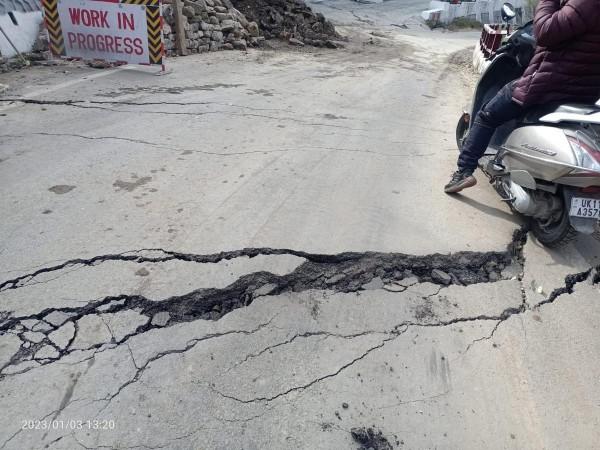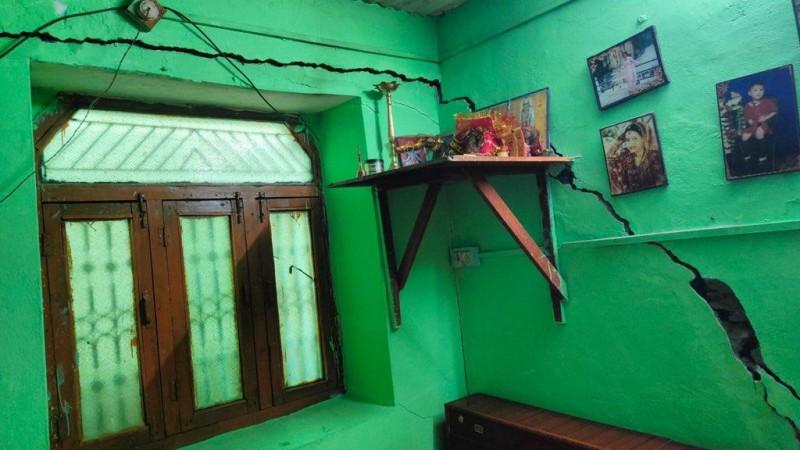Tribes and communities in the hills know all too well what happens when you mess up with nature and its delicate balance. In another unfortunate incident, on Tuesday, two people were killed, two critically injured after a building collapsed at Helang, around 13 kms from Joshimath in Uttarakhand's Chamoli district.
State Disaster Response Force got into action and pulled one body from the rubble while the search and rescue efforts were on. Reportedly, seven people living in the building worked at a nearby crusher unit on the banks of the River Alaknanda. In another related incident, a bridge connecting Goundar village and Madmaheshwar valley got washed away, leaving over 50 stranded.

A man-made natural disaster?
The building collapse near Joshimath has been more of a disaster in the making rather than an unexpected turn of nature. At the site of the collapse, 868 structures have developed cracks and 181 of them have been declared unsafe. Each year, the monsoon season poses an alarming threat to the town, and with monsoon itself being unpredictable and heavy, there is a tragedy waiting to happen. Five families from Joshimath's Sunil Ward have been shifted to relief camps already this month and residents fear structural instabilities to only mount with passing time.
Residents' plea falls on deaf ears
Joshimath residents have been demanding their rehabilitation under the banner of Joshimath Bachao Sangharsh Samiti (JBSS) with another assembly convened on August 21.
Protests, agitation and assemblies have been one way of making those in power pay heed. Earlier, the residents suspended their 107 day long agitation after assurances from Chief Minister Pushkar Singh Dhami. The assurance came following the demand by Samiti for Rishikesh-Badrinath highway blockade on the inaugural day of Badrinath Yatra in the last week of April.
The Samiti also organized protests over three subsequent months to remind the government of its unfulfilled promises, with the convener of the Samiti saying that they were forced to relaunch the agitation as they had been deceived.

Joshimath — A look at the disaster at length
Joshimath, a town built on stabilized natural landslide debris in the mountains of Uttarakhand's Chamoli district, is nothing short of a hot spot for ecodisaster currently. Also the gateway to famous pilgrimage sites like Badrinath and Hemkund Sahib and skiing destination Auli, Joshimath is facing social and ecological turbulence due to land subsidence.
In January of this year, the biggest alarm bells rang when in Joshimath's Singhdhar, several houses gave way in the midnight hours of January 2 and 3. Although no lives were lost, cracks started developing at breakneck speed in several houses in the area, including a temple, which eventually collapsed. By the end of the first week of January, around 500 homes developed cracks, forcing Chief Minister Dhami to assure the residents, "A team of experts is camping in Joshimath to study all aspects of the problem and everything will be done to save the town." The first reported crack came from Gandhinagar ward in November 2021.
After the state and national agencies swung into action, satellite images of the town released by ISRO showed that the town sank at an alarmingly rapid pace of 5.4 cms in a span of just 12 days, between December 27, 2002 and January 8, 2023 due to the possible subsidence on January 2. That's not it, in fact ISRO's preliminary report showed that the entire town may sink.

After the ISRO images triggered panic among the residents and led to protests, National Disaster Management Authority (NDMA) instructed a dozen government institutes and scientific organizations not to interact with the media, share data or opinion of any kind regarding subsidence at Joshimath. The preliminary report and images released by ISRO were also taken down from National Remote Sensing Centre's website.
The move, at the time, prompted several netizens and affected residents to remark that if the authorities can't find the solutions, they'll control the discussion of the problem.
How did the situation come to this far?
Many across the nation collectively wonder, how did the situation come to this? Unmonitored up till reaching the point of collapse. Himalayan disasters in the state, like in Varunavat, Kedarnath and Rishiganga have been happening with alarming consistency. Evacuation and rehabilitation are a small part of the solution. Reportedly, cracks have begun to appear in several other regions and smaller villages and hamlets too.

When IBTimes got in touch with Manish Khanduri, AICC member who contested the 2019 Lok Sabha elections from Garhwal and knows the region all too well, emphasized the need to look at the issue from a macro level. "Helang is on route to Joshimath and not inside the town, but what this is indicative of is the fact that there is trouble in the entire region."
Without denying that the unprecedented monsoon has only made the situation even impossibly worse, he likened it to a malaise rather than a specific disease. Now the question that needs to be immediately answered is not, "What went wrong? but rather, "Now what can be done?"
He cites an example, "There is no systemic level or institutional level study of what is effective in the hills. For example, a company is given the task of constructing a road, they go about blasting the site, construct a road and leave."

The haphazard, unregulated and unprecedented construction in the Himalayan region has to completely stop immediately, he says while further sharing his apprehension about the technological soundness and safety factor of a rail project in the state entailing the country's longest rail tunnel.
"The entire approach towards hill development needs an overhaul, outside contractor business has to stop, we need environmental experts, agencies and institutions taking stock of inventory before going ahead with any development or construction work. And most importantly, once construction has been done, we need continuous monitoring."
Until that happens, "Unfortunately, we'll be having the same conversation, holding the same discussion only with a similar tragedy elsewhere in the region," he warns before signing off.














